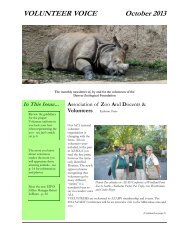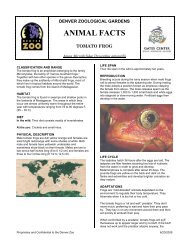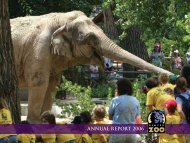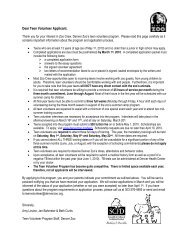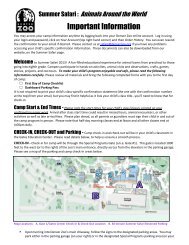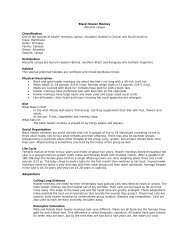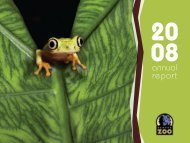Rhinoceros Hornbill Buceros rhinoceros Classification ... - Denver Zoo
Rhinoceros Hornbill Buceros rhinoceros Classification ... - Denver Zoo
Rhinoceros Hornbill Buceros rhinoceros Classification ... - Denver Zoo
Create successful ePaper yourself
Turn your PDF publications into a flip-book with our unique Google optimized e-Paper software.
Distinctive Casque<br />
The distinctive casque on top of their bill looks heavy and cumbersome. Composed of keratin<br />
overlying bony support, the casque is very strong and relatively lightweight. The casque is used in<br />
recognizing the age, sex and species of the hornbill. It also acts like a resonating chamber that<br />
amplifies their loud squawks.<br />
Conservation Connection<br />
IUCN Status: Near Threatened.<br />
<strong>Rhinoceros</strong> hornbills are listed as near threatened due to loss of habitat, poaching for their feathers and<br />
hunting for food.<br />
Fun Facts<br />
• When flying, the wings of the hornbill make a loud humming sound that can be heard up to 65 feet<br />
away.<br />
• Males have red eyes and females have white eyes.<br />
• <strong>Hornbill</strong>s have very long eyelashes that protect their eyes from injury. The eyelashes are actually<br />
modified feathers.<br />
• <strong>Hornbill</strong>s are the only birds that have the first two neck vertebrae fused together. Along with strong<br />
neck muscles, the fusion of the vertebrae helps support the weight of their large bill and casque.<br />
• While enclosed in the nest chamber, the female undergoes a simultaneous molt of all flight and tail<br />
feathers. She grows new feathers by the time she emerges from the nest.



